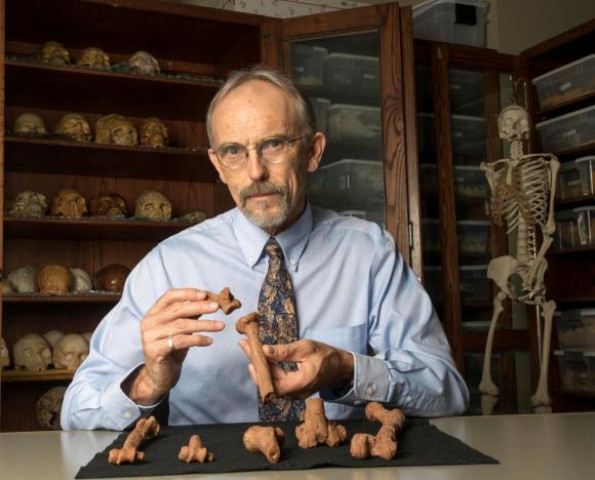Human ancestor Lucy spent much of her time in trees: study
Lucy is the most ancient hominid fossil from the evolutionary branch that led to humans

Paleoanthropologist John Kappelman is seen with 3D printouts of Lucy’s skeleton illustrating the compressive fractures in her right humerus that she suffered at the time of her death 3.18 million years ago in this image from the University of Texas at Austin, U.S. for release on November, 30, 2016. Courtesy Marsha Miller/The University of Texas at Austin/Handout via REUTERS
Our 3.18 million-year-old relative, whose fossilised partial skeleton was discovered in Ethiopia in 1974, likely got around as much like a modern chimpanzee as a modern human, according to a new study published in the journal PLOS ONE by scientists at Johns Hopkins University in Baltimore, Maryland and the University of Texas at Austin.
Heritage site: Exploring last vestiges of ancient Buddhist monastery
The beloved, 3-foot-6-inch (about one meter) bipedal Australopithecus afarensis has confounded paleontologists for years. They have been debating whether the 60-pound (27 kilogram) hominid spent most of her time on the ground, like modern humans, or in the trees, like chimpanzees.
The study finds that Lucy had strong upper arms, suggesting she regularly climbed trees. She also had relatively week legs that were not used for climbing and were inefficient for walking.
The combination of the two discoveries led researchers to conclude that Lucy probably nested in tree branches at night in order to avoid predators, used her arms to travel between trees and may have even foraged for food among branches.
The researchers arrived at their conclusions by conducting new high-definition scans of Lucy's bones -- combining 35,000 individual images taken with a powerful scanner capable of penetrating the layers of minerals in her fossilised remains.
They studied the internal structures of the upper bones of Lucy's two arms, and the femur bone of her left leg, discovering that her upper limbs were highly developed -- suggesting they sustained strong muscles similar to tree-climbing modern chimpanzees.
Public ownership of heritage sites advocated
"It is a well-established fact that the skeleton responds to loads during life, adding bone to resist high forces and subtracting bone when forces are reduced," said John Kappelman, an anthropology professor at the University of Texas, and one of the main authors of the research.
Chimpanzee skeletons have more solidly built upper limbs, because they use their arms to climb, while humans have more developed lower limbs due to walking, according to Christophe Ruff, anatomy professor at The Johns Hopkins University and a co-author of the study.
"The results for Lucy are convincing," he said.
Another recent study concluded that Lucy probably died from a fall from a particularly tall tree. The study, published in the British magazine Nature, arrived at that conclusion after analysing a bone fracture in Lucy's fossilised remains.
But scientists have had trouble determining exactly how much of Lucy's time was spent off the ground. The new study suggests that if she slept around eight hours a day, she would have spent at least a third of her time in and among branches.
Afghan museum highlights country’s Buddhist heritage
Other comparisons in the study suggest that even when Lucy walked on her two legs, she did so less efficiently than modern humans, limiting her ability to move long distances by foot.
Long considered the longest living human relative, Lucy was dethroned of her status in 1994 following the discovery -- also in Ethiopia -- of Ardi, a female Ardipithecus ramidus who lived 4.5 million years ago.
She is the most ancient hominid fossil from the evolutionary branch that led to humans.


















COMMENTS
Comments are moderated and generally will be posted if they are on-topic and not abusive.
For more information, please see our Comments FAQ